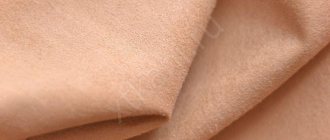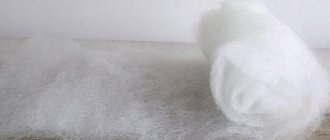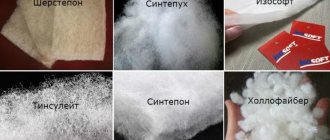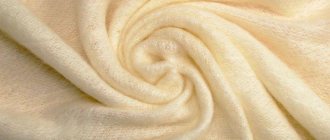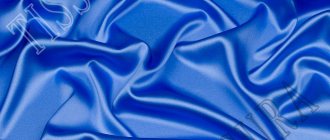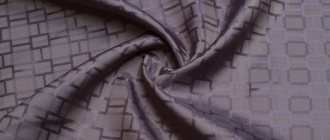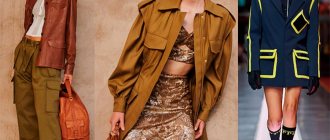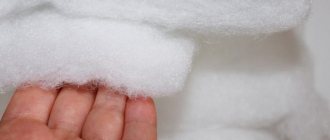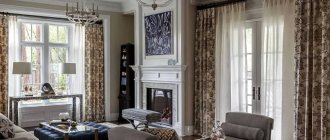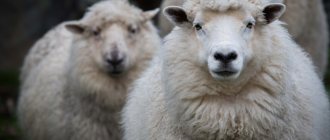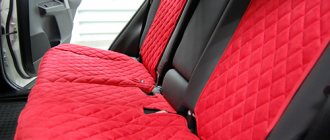Materials with the prefix “eco” are already conquering the world’s catwalks, with models sporting eco-leather, eco-suede and eco-fur. Humanity is slowly “waking up” and Natural furs in America and Europe have already become a sign of bad taste. Our country is a little behind, but Eco-fur has finally reached Russian beauties)
But the podium is one thing, but real conditions, especially in northern latitudes, are completely different. In warmer countries, this is more of a fashion accessory and, although our ladies also want to look luxurious, the practical side is no less, and sometimes even more important, than the beauty of faux fur. Frosty winters do not forgive carelessness. Many are worried - is it warm enough, will I freeze in it, is it harmful to health, and in general - what kind of animal is this?
For several days I “flyed” on the World Wide Web, soaking up information from manufacturers, reviews from those who had already tested the new product, recommendations (I, too, as a super-practical girl living in cold Mother Russia, was terribly curious!). Now I bring everything I have collected to your attention in several articles. This is the first, introductory one. The next one will describe all the rules for caring for eco-fur. Let's begin!
So, eco-furs are already on the shelves of our stores and hundreds of buyers of high-quality faux fur coats are absolutely delighted (oops! spoiler)). Many famous brands and designers use eco-fur in their collections and demonstrate them at world shows, including Alice + Olivia, Stella McCartney, Shrimps, Patrizia Pepe, Sonia Rykiel, Michael Kors, Giamba. Domestic designers are also catching up, for example Katerina Dobryakova and Lyudmila Nikishina.
Eco-fur is firmly in fashion and in the minds of humanity)
And for those who are hearing about him for the first time - get acquainted)
The first artificial fur was “born” back in 1929. Natural fur was glued onto the fabric, but such a “Frankenstein” was capricious and short-lived, which did not contribute to its popularization and this idea was abandoned.
In the early 60s of the 20th century, the technologies of that time began to make it possible to draw fibers from polymers by heating them. This is how the first eco-fur appeared. Low quality and very different from natural, but still deservedly adorned hundreds of women and saved thousands of animals.
Total craze for faux fur in the USSR
Today we have the happiness of using high-tech fabrics, dressing ourselves, pets and interior items in soft luxury without harm to animals . The old and bulky faux fur has been replaced by the brand new Eco-fur.
Eco-fur is a new modern material that very successfully imitates natural fur.
In appearance you can’t tell it from the real thing , it’s soft and gentle to the touch.
Content:
- Advantages and disadvantages of natural fur
- Advantages and disadvantages of faux fur
- How to distinguish faux fur from natural fur?
With the development of the chemical industry, faux fur is actively used in the clothing materials market. It perfectly imitates natural fur, while modern developments are practically not inferior in quality to natural raw materials. But still, the industry has not yet been able to completely replace natural animal skins with artificial materials.
What is eco-fur made from?
Now manufacturers have new generation equipment that allows them to make hairs very similar to the hairs of animals. These fine fibers are evenly applied to artificial leather or a woven base made of synthetic and natural threads so that it is akin to natural fur. The fibers themselves are made from nylon, polyacrylonitrile (whatever that means), viscose, and lavsan.
Fur pillows are in fashion now) Eco-fur is made in different ways. These are the most popular: Knitting and stitching “wool” from twisted cord (chenille) is knitted into a woven base. Fabric-stitching tufting machines stitch the base fabric with fiber loops, which are subsequently cut to form “fur.” The material is glued on the reverse side. Woven in the process of making the base fabric, the pile is already woven into it, and after completion it can be glued. Glue (invoice) is one of the main ones. The pile is glued to the base and combed. This method is used to make sheepskin, arctic fox, mink, silver fox, leopard and others. The villi are made short to imitate the undercoat and long to imitate the guard hair. They are “planted” in the same way as animals - the “undercoat” is thicker, the “wool” is thinner, and the result is a very high-quality “fur”. Knitted fabric is knitted on industrial machines with loops, which are glued with film on the reverse side for strength.
Sometimes a special vapor-permeable film is applied to the outer side of the canvas to protect against precipitation. To make it even more “convincing,” Eco-furs are dyed and trimmed “to suit a specific animal.” Sometimes these procedures are purely decorative.
Methods of decorating Eco-fur.
- Plain-dyed - dyeing the pile in one tone along the entire length.
- Melange furs are a method of applying several colors to the fur, most often certain patterns, such as lynx, tiger or cheetah.
- Curling is most often used for sheepskin and astrakhan fur.
- With the help of embossing you can “push through” any patterns. Painting occurs using stencils and sprayers (airbrushes) and, as a rule, is done in layers. Read how to dye fur yourself here
So, Eco-fur is also artificial, like its predecessor, only of much higher quality. It is also called "Eco Fur". To avoid confusion, we will call Eco-fur (the new generation) that, and we will call the old generation simply “artificial”.
Specifics and properties of natural suede
Suede is a type of genuine leather produced by fat tanning. There are two types of material. To obtain an unrefined variety, the skins of sheep and calves are used. Such skin is dense, but it is difficult to withstand mechanical stress.
The refined variety of suede is more in demand due to its softness and fineness. It breathes and is characterized by comfortable use. This material is obtained from the skins of goats and deer. In addition, vegetable fats are used in the production of the product, including flax oil, bone or fish oil.
To obtain natural suede, wool is removed from the skin, the remainder is greased and processed. When the fat is completely absorbed and becomes one with the protein of the skin, the material is painted and, if necessary, decorated. The result is high-quality natural suede with light fleecy, which is resistant to moisture and wear.
Despite its resistance to moisture and wear, the material requires careful care and use. Suede does not tolerate large amounts of moisture, so do not wear suede items in the rain. Do not dry products on a radiator or using electrical appliances; use special impregnations and sprays. How to care for suede items and renew suede, see here.
Products made from eco-fur - is it dangerous for health?
Times are changing and cheap, smelly synthetics containing a bunch of harmful substances are being replaced by a new generation of modern materials that are safe for people and the environment. Eco-fur is one of them.
- No toxic mixtures are used for its production
- Microbes do not live in these fibers
- Allergy sufferers wear eco-furs completely calmly ; there is no reaction to them.
- Products made from this material can be safely purchased for children, pets and used in home decor, without fear for the health of your loved ones and your own.
- For me, the most important advantage is that it preserves the health of millions of innocent animals
An arctic fox is an arctic fox. And he is wonderful!
Differences from nubuck and velor
Pay special attention to nubuck and velor. These are more affordable materials that are similar in appearance to natural suede. But the latter is flexible, elastic and soft. And the original retains these qualities even after getting wet and drying.
Velor and nubuck become hard and unpleasant to the touch. When wet and after drying, the fibers of such materials stick together, and the products lose their aesthetics and attractiveness. Traces and imprints remain on the surface, and creases in the pile form in different directions. Shoes made of velor or nubuck dissolve faster and last much less.
Velor is a dense and soft material with a velvety and fleecy surface. Unlike suede, it deforms when interacting with moisture and detergents. Velor is used for upholstery of upholstered furniture, tailoring, curtains and accessories, for the manufacture of car and furniture covers.
Velor has pile on only one side, while suede has pile on both. It has a solid color and fingerprints remain on the surface. The long and thick pile of velor easily changes directions, and the material itself does not bend and is cheaper. In addition, it wears out quickly and attracts dust, threads and hair. And creases easily form on the surface.
Nubuck is a thin and viscous material that, in a fairly short period of time, loses its physical properties, shape and presentable appearance. It is smoother and cheaper than velor and suede. Nubuck is used to make shoes and bags, various accessories, outerwear, and sometimes furniture.
Nubuck gradually wears out and becomes dull, and wear marks, stripes and cracks form on the surface. The life of such products can be extended with proper care and careful use. How to care for nubuck items at home, see the link.
Application of Eco-fur.
People's ideas about what fur should be are changing. Humane treatment of animals, humanity and kindness are gradually coming to the fore , which means that fur should not be the cause of massacres . Some cities, and even entire countries, follow advanced views on the origin of this raw material and prohibit the sale of natural furs. However, city dwellers do not deny themselves Eco-furs as luxury accessories, which proves that they are not against fur in general. Let's take a closer look at how you can use Eco fur even in sunny countries.
- Production of clothing - both entirely and only the finishing of sleeves and hoods.
- The shoes are decorated on the outside and insulated on the inside.
- Elegant fur hats and scarves are also popular.
- Fur handbags, collars and eco-fur wallets are now the trend of the season.
- Eco-friendly “skins” can be hung on walls, they can be used to make blankets, bedspreads and pillows , and decorate screens with them.
- Don't forget about fluffy cozy rugs.
- Shaggy ottomans and sofas look interesting and unusual.
- Children have already liked soft toys On the Internet I increasingly come across topics like “how to sew a bunny from eco-fur” or something similar.
It's nice to lie on a blanket made of eco-fur)
What should you pay attention to?
When choosing a fur product, you first need to study the label. In most cases it is on the wrong side. The tag must indicate the materials used for manufacturing, composition, serial number, country of origin, manufacturer's address and other contacts. All inscriptions must be legible. Sometimes the label also includes care instructions.
In addition, products made from natural fur are in most cases branded, and therefore, when you see the brand name, you can safely search for information about the manufacturer on the Internet.
We should not forget that real fur cannot be cheap, because the production of such products requires high costs. Therefore, the low cost of a mink coat or boots with sheepskin should alert the buyer.
Also, when deciding to purchase a natural product, you should pay attention to its weight. Animal wool will always be slightly lighter than synthetic material. It is also necessary to take into account the presence of odor - there should not be any.
You should not believe sellers who say that the product has been sitting for a long time and therefore lint is falling out of it. Natural hairs should not fall out. Otherwise, we can talk about the fur being synthetic or that the animal could have various diseases.
Looking at the back of the product, you will notice that there are stamps on the skin, usually purple, and pieces of leather are sewn with small seams.
Important: some types of modern synthetic furs can also have a high cost, which is associated with high production costs.
Pros and cons of Eco-fur, how it differs from “old” faux fur and from natural fur.
Advantages of Eco material.
- The first and most important thing is to save millions of animal lives . The hunt for these beautiful creatures has already endangered hundreds of species of animals. The Red Book is a disgrace to humanity . In the wild, a few lynxes, tigers, leopards, seals and goats roam alone. By the way, the death penalty is provided for killing a very rare Far Eastern leopard in China .
- It looks as luxurious and “expensive” as natural skin.
- soft and silky to the touch , which is strikingly different from its old brother. I remember this synthetic squeak and plastic hairs - I had similar clothes in which I looked more like a pink furry bun than a princess. Then I reshaped it into a bag, to hell!
- Eco-fur is not afraid of wet and snowy weather . It does not get wet through and dries quickly. When wet, it does not emit unpleasant odors, like fur coats made from natural fur, and does not roll into “icicles” like artificial ones. All you need to do when you get home is to dry it naturally on a hanger, carefully combing the product in the process and there are no problems)
- He is not very picky about his care. It can be safely washed on delicate cycles without spinning in a washing machine. Natural furs are still capricious, and if cleaned, it is exclusively dry and it is better to dry clean them.
- Eco-furs do not pill, do not cake or wrinkle , just like real ones.
- It is lighter than artificial and natural, it is pleasant to wear.
- Eco-furs are warm due to the vapor permeability of the base. They can withstand, according to various sources, from 15 to 30 degrees below zero. It depends on what kind of insulation is used in the product.
- Its wear resistance indicators are much higher than those of old artificial ones, and are the same, and sometimes even superior (depending on the quality of the raw materials) to natural things.
- Manufacturing technology allows you to create material of any thickness, color, style , which only encourages designers to create truly masterpieces. Do you want a golden fleece, or do you want a silver fleece).
- In addition, you can make fabrics of any size, this greatly facilitates cutting, which means that the clothes will have fewer seams , which, in natural fur coats, tend to diverge and stretch over time.
- The moth does not eat artificial furs (she has indigestion), but she happily slurps natural furs along with all the anti-moth bags that we so carefully lay out in our closets. Even if you protect your natural fur coat from moisture and properly care for it - one family of moths... whatever - just one moth can devour your at least 70,000 in a few weeks, making disgusting holes.
- And eco-furs, with all the described advantages, are many times cheaper. If natural fur from, say, mink, will cost from 70,000 rubles, then from ermine it costs 120,000 and more. Prices for “the same” eco-fur coats start from only 15,000-20,000 rubles. Isn't this a wonderful bonus? Just imagine - for 70,000 (which you would spend on 1 natural fur coat) you can buy at least 2 different fur coats and dress them according to your mood. Therefore, chic parkas and eco-fur jackets are now available to any fashionista.
For every taste and color!
Disadvantages of Eco-fur.
- If you run your hand over it, you will distinguish it from the natural one (sometimes not the first time). But if you had nothing to compare with, believe me, the fluffiness and softness of high-quality Eco-fur would leave you with no doubt that this is a worthy material.
- Scientists have not yet achieved the same heat levels as natural fur. But this problem is very easily solved with a more frost-resistant insulation, for example, Tinzuleit (polyester-based), which can withstand temperatures down to -30-40 degrees Celsius, without weighing down or “blowing” the product, like synthetic winterizer. It is thin and warm, and also “breathes”. By the way, mink or rabbit fur, which is often used to make fur coats, has a rather “liquid” undercoat, which is supposed to keep you warm, so in cold weather such a thing is of little use. That’s why they are also additionally insulated.
- If washed incorrectly (over 40 degrees), it may shrink as it may contain cotton fibers. But improper care has ruined many natural products.
- The only negative I would have called electrification if I had lived a couple of centuries ago, but, fortunately, manufacturers of anti-static agents and special anti-static detergents for washing synthetics took care of this too.
- Eco-fur is afraid of high temperatures - over 40 C, so it is not recommended to use it where it can get very hot, for example, on heated seats.
- A high-quality product cannot be downright cheap; you will still have to spend money.
- While the material is new and people know little about it, there is a risk of buying a fake from an old generation of fur, which, of course, will not have all the advantages of Eco-fur. You have to be careful here. Exactly the same as with the purchase of a natural fur coat, which can also climb, shed and unravel if it is poorly sewn or the skins were processed incorrectly. Only in the case of false fur you will lose much less money.
If you wash it incorrectly, your vest is only for a pet)
Characteristics of artificial suede
Artificial suede is used to create budget and affordable shoes, clothing and accessories. The material is produced by two methods. In the first case, split microfiber threads are used, which make the product fleecy. The fabric is soft and pleasant to the touch.
In the second method, a polymer coating is applied to the fabric base and polished with a special laser. The result is an aesthetic and comfortable material, which is finally coated with a beautiful coating. However, artificial suede is not resistant to wear and abrasion, moisture and water, temperature changes, frost and heat. It does not allow air to pass through, which causes discomfort when using shoes and clothing.
Due to modern technologies and the processing of synthetic materials, it is becoming more difficult to distinguish between natural and artificial suede. In addition, the products are similar in appearance. We offer some tips to help you determine whether it is natural suede or not.
How to identify high-quality eco-fur?
- The first thing you should pay attention to is the uniformity of coloring . If you see stains, dark or light spots, refuse to purchase. Most likely, the production and dyeing technology was violated and in the future the pile may begin to shed or climb.
- Smell the product . If you smell sharp, chemical or other unpleasant odors, it is a fake or there were serious technological violations during the production process. Look for another store.
- Run a damp hand or cloth over the fur. You need to make sure that the lint does not fall out . You can lightly tug the fibers to see if they sit firmly on the base.
- The product must have a label from the manufacturer with information about the composition and methods of care. The most durable is considered to be pile or polyester.
- Inspect all seams for poor stitching and pile jams. Make sure all parts are sewn correctly.
- Do not go to the market or mass market for Eco fur. They may not even know what it is, and when you explain that this is high-quality faux fur, the sellers will happily nod their heads and hand you some faux old stuff, sincerely believing that this is what you are looking for. Therefore, go straight to specialized stores , where they know exactly what Eco-fur is and how it differs from the old model.
The more people choose artificial materials, the more motivation manufacturers will have to make them better and better, surpassing natural fabrics in all respects. And, of course, the main thing is that the more living furry animals with beady eyes will run around the Earth.
| Don't you want to kiss this beauty? | I don’t know about you, but my heart is breaking( | This must stop! |
So that the article is not unfounded, here is a short video . At the end is an advertisement for the Eco-Fur Fur Coat store. You can adopt it yourself or simply ignore the brand. I chose this video not because of it, but because of people's real opinions . The result surprised me too))
The truth about eco-fur
If you bought a synthetic analogue instead of natural raw materials, I firmly shake your hand with great gratitude from the bottom of my heart). Eco-fur is a conscious choice of a new generation of humanity - humane, fair, kind. Let's all stop paying for the genocide of our smaller brothers and neighbors on the planet , enjoying the beauty and warmth of artificial fur coats.
Readers rate the article (5 ratings, average: 5.00 out of 5)
And you?
